Chronic
In 1917 a Joint Committee on Institutional Treatment was appointed by Mr. George Barnes (1859-1940), the first Minister of the newly formed Ministry of Pensions. The Committee's purpose was to instigate provision of suitable institutional care for discharged men who had been disabled while serving in the Forces during the war. The first of these to come under consideration were paraplegics, neurasthenics (the shell shocked), epileptics and those with advanced tuberculosis.
The Red Cross, via the Joint War Committee, placed a large sum of money at the disposal of the Joint Committee on Institutional Treatment to use to acquire and equip the institutions. Local committees or local authorities would then manage and administer them, while the Ministry of Pensions would pay for any general maintenance work.
Since 1916 incurably paralysed servicemen had been transferred to the care of the Star and Garter Home in Richmond but, at the beginning of 1918, the Committee decided to establish another home for these men, and a house in Poynders Road, Clapham Park, was taken on a 14 year lease, given free of charge.
Lonsdale House, once known as Chios House, had large gardens. The building was fully equipped by the Joint Committee on Institutional Treatment from the fund provided by the Joint War Committee. All rates and taxes were paid for by voluntary subscription.
The Hospital could accommodate 32 patients. Bed-ridden cases were located on the ground floor, with walking patients on the first floor. The ground floor also contained the dining room and the day rooms. The kitchen, store room and staff dining room were in the basement. The second floor contained the staff quarters.
Patients were allowed as much freedom as was possible; each had a wheelchair and visitors were allowed every afternoon. Handicraft classes, such as basket-making, were held if any of the patients showed an aptitude.
In April 1918, once the Hospital was in full working order, the Ministry of Pensions handed it over to the National Hospital for Paralysis, Queen Square, who had agreed to administer it on behalf of the Ministry. All patients for admission were to be nominated by the Ministry, who paid a capitation fee for each one (by 1929 this was 9s (45p) a day). The National Hospital provided any necessary medical care (as Lonsdale House had no operating theatre, patients needing surgery were transferred to Queen Square, returning as soon as convalescence allowed).
The Hospital proved useful. Its beds were always occupied and, following physiotherapy and electric treatment, some patients even improved in health and general condition. Some, who had been considered permanently paralysed, even recovered their powers of movement to a remarkable degree.
The Hospital closed in 1936.
Present status (August 2010)
Lonsdale House was demolished and its site is now occupied by Poynders Gardens, a housing estate with 282 homes, built by the LCC at the end of the 1930s.
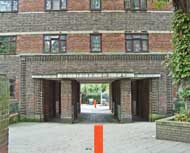
The approximate site of Lonsdale House in Poynders Road.
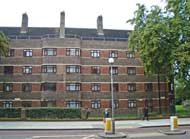
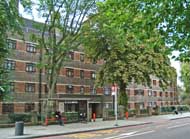
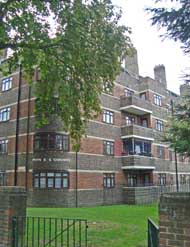
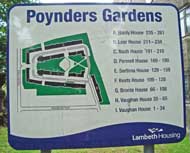
The rather elegant housing estate of Poynders Gardens was built by the LCC just before WW2, replacing the earlier housing in the area.
(Author unstated) 1920 National Hospital, Queen Square. British Medical Journal 1 (3091), 451.
(Author unstated) 1924 The N.F.A. British Medical Journal 2 (3321), 335.
(Author unstated) 1921 Reports by the Joint War Committee and the Joint War Finance Committee of the British Red Cross and the Order of St John of Jerusalem in England on Voluntary Aid rendered to the Sick and Wounded at Home and Abroad and to British Prisoners of War, 1914-1919. London, HMSO. (Reprinted in facsimile, 2009. The Naval and Military Press Ltd in association with the Imperial War Museum).
http://hansard.millbanksystems.com
www.queensquare.org.uk (1)
www.queensquare.org.uk (2)
Return to home page